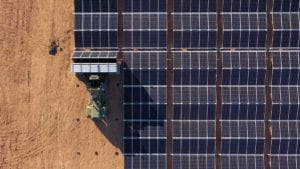Microwave technology invented at Australia’s Macquarie University promises to deliver “massive savings of energy” in the manufacture of solar cells, while also making them easier to recycle at the other end of their life cycle.
In a paper published in the US Journal Applied Physics Letters, a Macquarie Uni team led by Dr Binesh Puthen Veettil has shown that microwave radiation works just as well to “anneal” solar cells – a high-temperature process usually performed by cooking them in an oven.
The study has shown that not only is heating the cells using microwave radiation “nearly as efficient” as traditional processes, but it saves considerable time and energy and offers other advantages – including for the sustainability of the cells.
“Because microwave radiation selectively heats silicon, it leads to almost instantaneous effects with massive savings of energy,” the School of Engineering team says.
“This is partly because the rest of the laminated panel of glass, plastic and aluminium is left largely unaffected. And that property that has led to an unexpected recycling benefit for which the group has a patent pending.”
The researchers explain that the unexpected benefit worth patenting is that under microwave treatment, the plastic coat that protects the silicon softens to the point where it can be peeled off mechanically.
This means the silicon plates can be easily delaminated and their components reused without the need for harsh chemicals – and a much stronger economic case can be made against just dumping old panels in landfill.
“Now, as the solar panels which began to be installed in vast numbers about 20-30 years ago are reaching the end of their life and being decommissioned, governments are demanding they be recycled,” Dr Veettil says.
Using current technology, Veettil says this crushing the panels, heating them to about 1400°C and washing them with chemicals to remove the plastic – “a highly energy-demanding process,” he says.
Beyond recycling, the microwave annealing has several other advantages, including being better at the sort of selective and highly tuned annealing required for more modern solar heterojunction technology, where crystalline and amorphous silicon are interleaved.
In these cells, using faster, better directed microwave-based annealing can be highly advantageous, the researchers say.
More precise focus also means that annealing can be directed to specific parts of the solar panel, making it ideal for annealing solar panels with more intricate internal structures made for special purposes.
Veettil also notes that microwave annealing takes is a much cleaner process, with less contamination and able to be undertaken at room temperature.
Meanwhile, a co-author of the annealing paper, Associate Professor Shujuan Huang, is also looking at the potential for microwave annealing in perovskite solar cells.
Dr Veettil’s research in collaboration with the school of photovoltaics at UNSW has been supported with funding from the Australian Centre for Advanced Photovoltaics and from Australian Renewable Energy Agency.








